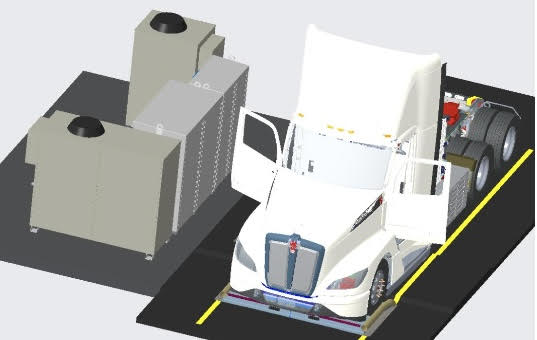Wireless Charging Technology for Semi-Trailer Trucks Developed by ERC
Outcome/Accomplishment
The NSF-funded Engineering Research Center (ERC) Advancing Sustainability through Powered Infrastructure for Roadway Electrification (ASPIRE), headquartered at Utah State University, has developed a megawatt charging pad for semi-trailer trucks that requires no physical connection. A field demonstration of the wireless charging system for daily commercial fleet operation is expected soon.
Impact/Benefits
With more widespread adoption of heavy-duty electric vehicles, advancing low cost, safe, and reliable charging station infrastructure will be key for the daily management of commercial truck fleets. The wireless charging pad developed by ASPIRE researchers could also reduce operations costs and the time it takes to charge a semi-truck.
Explanation/Background
The innovative wireless technology developed by the NSF-funded Center brings power to where the trucks are parked. This eliminates moving parts that can be difficult to navigate for large vehicles and reduces maintenance and operations costs. A demonstration using a single pad smaller than 2 square meters transferred 850 kilowatts of power with 95% efficiency, enough to charge large vehicles like semi-trucks in less than half an hour.
Location
Logan, Utahwebsite
Start Year
Energy and Sustainability
Energy, Sustainability, and Infrastructure
Lead Institution
Core Partners
Fact Sheet
Outcome/Accomplishment
The NSF-funded Engineering Research Center (ERC) Advancing Sustainability through Powered Infrastructure for Roadway Electrification (ASPIRE), headquartered at Utah State University, has developed a megawatt charging pad for semi-trailer trucks that requires no physical connection. A field demonstration of the wireless charging system for daily commercial fleet operation is expected soon.
Location
Logan, Utahwebsite
Start Year
Energy and Sustainability
Energy, Sustainability, and Infrastructure
Lead Institution
Core Partners
Fact Sheet
Impact/benefits
With more widespread adoption of heavy-duty electric vehicles, advancing low cost, safe, and reliable charging station infrastructure will be key for the daily management of commercial truck fleets. The wireless charging pad developed by ASPIRE researchers could also reduce operations costs and the time it takes to charge a semi-truck.
Explanation/Background
The innovative wireless technology developed by the NSF-funded Center brings power to where the trucks are parked. This eliminates moving parts that can be difficult to navigate for large vehicles and reduces maintenance and operations costs. A demonstration using a single pad smaller than 2 square meters transferred 850 kilowatts of power with 95% efficiency, enough to charge large vehicles like semi-trucks in less than half an hour.

